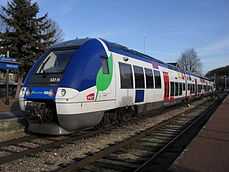Multi-system (rail)
A Multi-system locomotive (also referred to as multi-system electric locomotive) is one that is able to operate using more than one railway electrification system,[1] such as the British Rail Class 92 which can operate from both 750 V DC third rail and 25 kV, 50 Hz AC from overhead lines.

As well as multi-system electric locomotives, there are also multi-system electric multiple unit, such as the Olympic Javelins and other multi-system trains, such as the Eurostar trainsets and Metro North's M2 railcars (right).
Multi-system trains are used to provide continuous journeys along routes that are electrified using more than one system. These may be electric multiple units built to serve long distance routes, often crossing national borders, or where newer high speed rail lines are electrified with the de facto standard of 25 kV AC from overhead lines whilst the adjacent classic lines use a different older system.
Multi-system electro-diesels

An electro-diesel locomotive or an electro-diesel multiple unit can also be multi-system, such as the SNCF Class B 82500 multiple unit train which can use both 1.5 kV DC and 25 kV AC both overhead, as well as having its own diesel engines.[2][3]
European Union
Prior to 1945 there was little demand for multisystem locomotives in Europe. From the 1950s onwards the formation of the European Union and the consequent increase in the amount of cross border traffic, and the addition of a 25 kV 50 Hz AC system in France in addition to the older 1.5 kV DC system both gave rise to new needs for multivoltage locomotives.[4] Very high capital costs prevent or hinder the adoption of a standard railway electrification system.[5]
At the beginning of the 21st century railway legislation in Europe (the First Railway Package and Second Railway Package, and the creation of a Trans European Rail Freight Network) liberalised cross border freight traffic, giving rise to demand for locomotives to work between European Union countries with different electrification systems. and creating a practically new market for multivoltage locomotives such as Bombardier's TRAXX.[6] However increase cost of purchase and maintenance, along with costs of different safety system installations for cross-border work have reduced the economic viability of multisystem vehicles versus the use of single voltage machines and locomotive changing.[7]
See also
- Double electrification
- Railway electric traction#Multi-system units
References
- ↑ "Traxx locomotive family meets European needs". Railway Gazette International. 2008-01-07. Retrieved 2011-01-01. "Traxx MS (multi-system) for operation on both AC (15 and 25 kV) and DC (1.5 and 3 kV) networks"
- ↑ "AGC Regional Train - France". Bombardier Transportation. Retrieved 2011-01-01. "The hybrid AGC combines certain operating features for the first time ever in a train. Dual-mode (electrical and diesel) and dual-voltage (1500 and 25000 V) technology enables the Hybrid AGC to glide seamlessly across the entire railway network and to access electricity from any available source."
- ↑ "Electro-diesel AGC launched on the world market". Railway Gazette International. 2007-10-26. Retrieved 2011-01-01. "BOMBARDIER Transportation staged a high-profile event on October 9 to mark the official entry into service of its AGC dual-voltage electro-diesel multiple-units..."
- ↑ Andreas Steimel (2007). "8. Multi-system traction vehicles". Electric Traction - Motion Power and Energy Supply. Oldenbourg Industrieverlag. p. 129.
- ↑ Hans-Jörg Bullinger (2009). "7. Mobility and Transport". Technology Guide: Principles, Applications, Trends. Springer. p. 295.
- ↑ Robert Wright (22 September 2008). "Multi-system: Competition improved by crossborder locomotives". www.ft.com. Financial Times.
- ↑ Pamela Luică (26 April 2011). "Multi-system locomotives, still too expensive for operators". www.railwaypro.com. Railway Pro.
External links
- M. M. Bakran, H.-G. Eckel, P. Eckert, H. Gambach, U. Wenkemann (Siemens AG) (20–25 June 2004). "Comparison of Multi-System Traction Converters for High-Power Locomotives". Power Electronics Specialists Conference, 2004. PESC 04. 2004 IEEE 35th Annual 1: 697–703. doi:10.1109/PESC.2004.1355833. ISBN 0-7803-8399-0. ISSN 0275-9306.